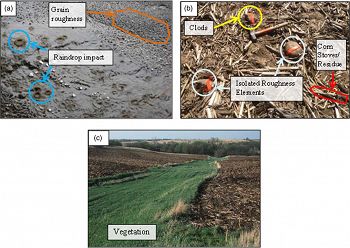Abstract

Images illustrating the various types of roughness encountered in Intensively Managed Landscapes that are examined in this study: (a) grain roughness and raindrop impact; (b) isolated roughness elements; and (c) vegetation. All images are from the Clear Creek Watershed, Iowa, and the Upper Sangamon River Basin, Ill.
Images illustrating the various types of roughness encountered in Intensively Managed Landscapes that are examined in this study: (a) grain roughness and raindrop impact; (b) isolated roughness elements; and (c) vegetation. All images are from the Clear Creek Watershed, Iowa, and the Upper Sangamon River Basin, Ill.
An improved modeling framework for capturing the effects of space and time-variant resistance to overland flow is developed for intensively managed landscapes. The framework builds on the WEPP model but it removes the limitations of the ‘‘equivalent’’ plane and time-invariant roughness assumption. The enhanced model therefore accounts for spatiotemporal changes in flow resistance along a hillslope due to changes in roughness, in profile curvature, and downslope variability. The model is used to quantify the degree of influence—from individual soil grains to aggregates, ‘‘isolated roughness elements,’’ and vegetation—on overland flow characteristics under different storm magnitudes, downslope gradients, and profile curvatures. It was found that the net effects of land use change from vegetation to a bare surface resulted in hydrograph peaks that were up to 133% larger. Changes in hillslope profile curvature instead resulted in peak runoff rate changes that were only up to 16%. The stream power concept is utilized to develop a taxonomy that relates the influence of grains, isolated roughness elements, and vegetation, on overland flow under different storm magnitudes and hillslope gradients. Critical storm magnitudes and hillslope gradients were found beyond which the effects of these landscape attributes on the peak stream power were negligible. The results also highlight weaknesses of the space/time-invariant flow resistance assumption and demonstrate that assumptions on landscape terrain characteristics exert a strong control both on the shape and magnitude of hydrographs, with deviations reaching 65% in the peak runoff when space/time-variant resistance effects are ignored in some cases.
Citation
Papanicolaou, A.N., Abban, B., Dermisis, D., Giannopoulos, C., Flanagan, D., Frankenberger, J., and Wacha, K. (2018): Flow Resistance Interactions on Hillslopes With Heterogeneous Attributes: Effects on Runoff Hydrograph Characteristics. Water Resources Research. DOI: 10.1002/2017WR021109
 This Paper/Book acknowledges NSF CZO grant support.
This Paper/Book acknowledges NSF CZO grant support.
 This Paper/Book acknowledges NSF CZO grant support.
This Paper/Book acknowledges NSF CZO grant support.



